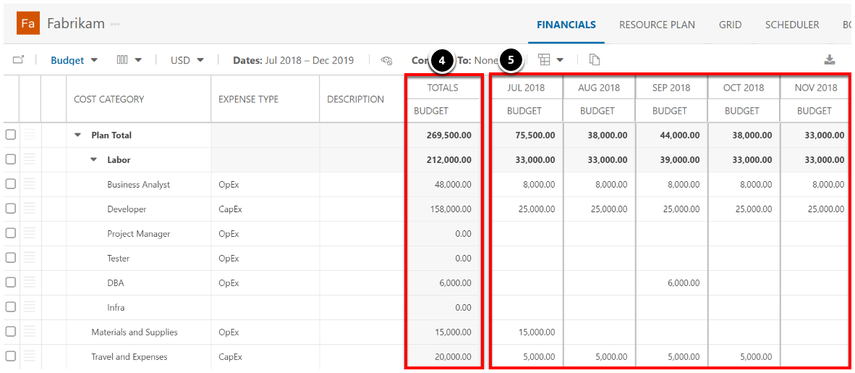How do I get around the Financial Planner?
This article explains the navigation and terminology of the OnePlan Financial Planner.
Heading

The Heading bar is where you may access the details of your plan and toggle between different planning modules for your plan.
Terminology & Use

1. Cost Types
Click the Cost Types drop down. Cost types allow organizations to calculate, evaluate and monitor what financial costs are planned, actually spent, and also financial gains. You can toggle from one cost type to another. A cost type may be editable or not. If not, the data is likely being imported from another financial system for reference.
Your organization may have similar or different cost types depending on business use cases and configuration. Here are some common general uses that may apply.
A Budget is the initial plan for what is estimated to be spent on this initiative. Expected costs are entered into cost categories. A cost category is how costs or gains are broken out into smaller defined categories. These are often organized as whether they are labor costs, and also whether they fall into expense type buckets, such as capital or operational expenses.
Once the Budget gets approved and a plan moves forward in the process, The Forecast costs are often used as the ongoing expected or estimated costs, updated as the plan or initiative continues. The forecast costs can be entered manually, or copied from another cost type, such as Budget. Then, updated as needed.
The Actuals cost type shows what has already been spent on the plan.
Another common example of a cost type is Benefits. This is where you would track what is expected to be gained from this plan. Notice the cost categories would be different in terms of what is gained vs another cost type for financials spent.
2. Cost Categories
Cost Categories, including Labor Cost Categories - Expected costs/financial values are entered into various cost categories. A cost category is how costs or gains are broken out into smaller defined classifications or groupings. The cost categories may differ per cost type. For labor cost categories, the number of hours entered into the Resource Plan can be imported as costs, calculated as hours x rate.
3. Cost Category Fields
The Cost Category Fields allow cost categories to be further grouped and clarified (i.e Expense Type & Description shown in the example above). Users may add detail rows to cost categories with additional information in the additional fields columns.

4. Cost Totals
The totals show per cost category, and than summary total for the whole plan.
5. Time-phased Cost Details
Costs are viewed and/or edited per time period shown. Based on the Dates menu selection, costs may be summed up or broken out in more or less details (i.e. daily, monthly, quarterly, yearly).
